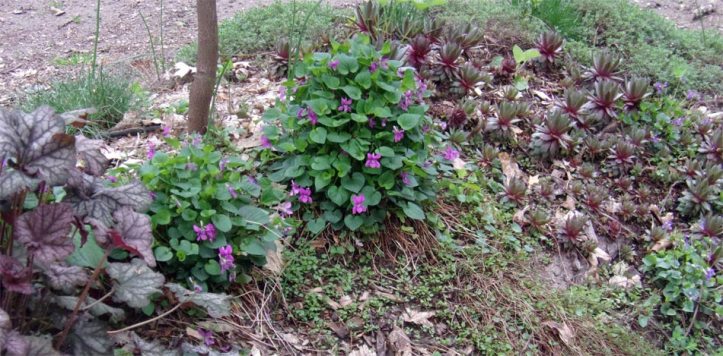I love the cool wetness of spring because it gives me the chance to shuffle plants around in conditions that make it easier for the plants to settle in to a new home with little trauma.
I have several reasons for plant shuffles. One is having an empty place I need to fill. As much as I love plant shopping and supporting our local nurseries, it’s much more economical and eco-friendly to use what I have on hand if it works.
Another advantage is strictly visual aesthetics. Having plants repeat throughout a garden gives a pleasing unifying look. I have lots of plants that are re-seeders and spreaders, so I have lots of material to choose from.
One of the reasons I am shuffling plants is that they have become crowded by more aggressive neighboring plants. This year I moved three daylilies that were sandwiched in between winter heathers. I have trimmed back the heathers the last two years, but it was ruining their natural shape! With the daylilies gone they can grow together in a nice fluffy heathery mass. And I’m sure the daylilies are all relieved to have some space to grow again!
I have serious mole challenges in most of my garden and some plants seem to handle that with no problem. Other plants slowly dwindle and die from being tunneled under. That’s the most common way I end up with a “bare space”. It gives me a chance to try a more mole-resistant plant in that spot.
Another reason I shuffle plants around is a purely artistic one. I love working with colors and textures and shapes! Sometimes I will notice that I have a plant in one part of the garden that is blooming in a color that is a perfect match or compliment to a plant blooming at the same time in another section. Since bloom time is not a good moving time for most plants, I will make a note in my journal – and next winter do another plant shuffle, getting those two plants closer together. Little groupings like this can have a truly mouth-watering effect in a garden!
I had one favorite combination a few years back that included a pink flowering plum tree with a mass of winter blooming heather (Springwood pink, if I remember right) at the base of it – in the same shade of lavender pink. It was such a beautiful effect!
Another was a pink flowering dogwood with a groundcover of blue flowered ajuga under it. If you can pull off a couple breath-takingly beautiful combinations here and there – it’s worth the effort!

Another thing the artist in me loves to do is work with leaf color. I have a wild plum that has a touch of purple to its leaves, so I planted a big purple leaf Heuchera, purple leaf Australian violets (with the added bonus of lavender flowers!), and purple hens and chicks surrounded by a low creeping thyme which also has lavender flowers.

I love using little groupings of tall perennials like Foxglove and Mullein as accents here and there. Small collections of iris have a similar – only shorter – effect. I grow iris more for the tough, carefree accents they add here and there, than for the very short-lived flowers. I don’t usually allow them to grow into masses because they lose the “accent” effect then.
One of my new favorites to grow in my various gardens is Rainbow Chard – the Swiss Chard with different colored stems. I plant the pink stemmed ones in my pink and silver garden and gold stemmed with a patch of yellow crocosmia by the potting shed. A big white stemmed one looks great with a white edged hosta and sweet alyssum!

What fun combinations have you discovered?

You are having Way too much fun!!! It’s great hearing you sound happy and playing in the garden.
JoAnn Dixon
LikeLike
Thanks JoAnn… I am having fun!
LikeLike
I thought that the title was funny because when we were kids, my colleague used to move plants to death. That meant that he would dig up and move established plants a few times. After getting dug too many times, some plants just died.
LikeLike
Wasn’t it you that said recently – all things in moderation… 🙂 That must go for plant shuffling too!
I have – on one or two occasions – moved plants more than once – but usually because they were struggling and I was trying really hard to find a place they would be happy! That’s a reason for moving a plant that I didn’t mention in my post… I have had it work wonders with some plants!
LikeLiked by 1 person
I just moved several flowering maples because they self sowed where they could not stay. However, once they get planted, they will stay put.
LikeLiked by 1 person
Sorry to hear about your mole problem.
LikeLike
You’re very kind hearted Helen…. I don’t think I have ever gardened anywhere where there wasn’t something to contend with… It’s all part of the fun of gardening! 🙂
LikeLike
True 😊 I have rats tunnelling rather than moles.
LikeLike
Ah yes… I have those too… I know because they take bites out of potatoes and carrots – and moles don’t like vegetables!
LikeLike